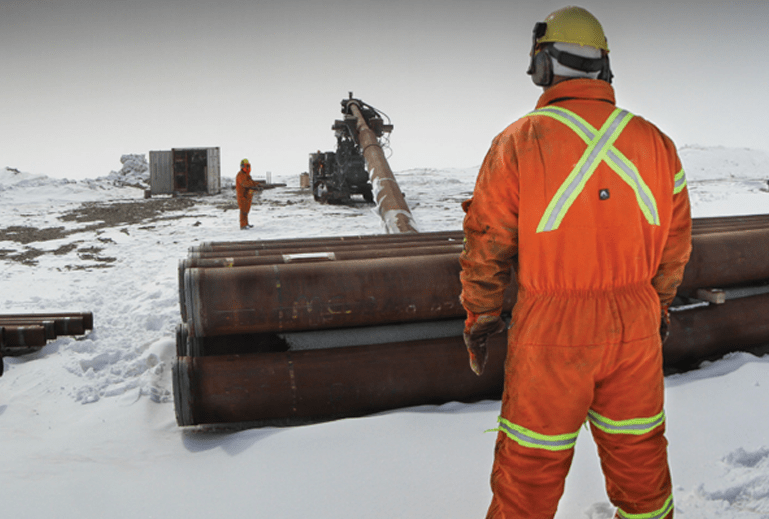
Ground freezing technology builds in unshakeable stability
Question: What ingenious consgruction technique has been around since the 1800s but is reserved for only the deepest, darkest jobs?
Answer: Ground Freezing
Primarily used to provide ground support, groundwater control or structural underpinning during construction, the technology is mainly used for mine shafts. But its simple, virtually fail-proof design has made it a more popular option for civil projects in recent years.
“Ground freezing is still used a lot in mining, but we’re seeing it used for civil work like water tunnels,” said Joe Sopko, director of ground freezing at Moretrench, a nationally renowned geo-technical contractor based in Rockaway, N.J.
What is ground freezing?
What is ground freezing?Ground freezing converts pore water to ice by circulating chilled liquid via a system of small-diam-eter piles in drilled holes. The ice fuses the soil or rock particles together, creating a frozen mass of improved compressive strength and impermeability. This is done in difficult, disturbed or sensitive ground.
The ground freezing process uses a series of drilled freeze pipes and large refrigeration plants to convert existing pore water in the soil to ice, creating a strong, watertight frozen earth material similar to rock or concrete. The frozen ground acts as an excavation support system requiring no bracing, tiebacks or additional shoring. It has been used extensively for shafts extending over a thousand feet deep.
Its impermeable nature eliminates the need for dewatering, making the technique practical for large groundwater barriers. These barriers can be used to reduce or eliminate flow into excava-tions and contain contaminants or restrict the flow of contaminated plumes.
The water that goes in is comprised of 32 per cent calcium chloride to ensure it will freeze effec-tively. While there are other coolants that could be used, saltwater has been found to be the most cost-effective.
“There are some rare applications in emergencies where we use liquid nitrogen, but those are small jobs and we get down to about -200 degrees Celsius,” said Sopko.
Depending on how warm the ground is at the outset, how thick the wall has to be and how deep the excavation is, freezing can take between five to 10 weeks and take up to a year to thaw out.
Moretrench makes It work
Moretrench has been the North American industry leader in this technology since 1970. And while their techniques have evolved over the years, so has the equipment.
“The advent of the screw compressor was a big deal because it allowed you to get the brine folder,” said Sopko.
Instrumentation is much more advanced as well. Contractors are able to get more data from the ground using fibre optics. With a better idea of what’s happening under-ground, design methods can be tailored to accommodate the exact conditions awaiting them. The ability to analyze heat flow and structural loads has been a boon for design, too.
Moretrench’s clients have historically included deep mines in Europe and Saskatchewan, though in recent years, have come to include the Port of Miami Tunnel, the East Side Combined Sewer Overflow Tunnel Project in Portland, Ore. and a New York City subway project, among others.
Sopko’s team is currently in the process of developing a ground freezing solution for Suncor Energy in Alberta. When a series of wells were installed and failed to keep the ground-water out, the company approached Moretrench to provide groundwater cut-off to one of their oilsand mines.
“We did a pilot test to see if the technology would work two years ago. It was successful and we’re now in the design and construction planning phase,” said Sopko.
Ultimately, it will be a seven-kilometre-long floating wall phased in over three to four years, and it will be operational (frozen) for 10 years.
When Is ground freezing most effective?
Sopko pulls no punches on this point: “You use it when noth-ing else will work.”
While remarkably effective, ground freezing is also expensive.
“Of all the ground modifications techniques, it’s the one that costs the most. But when other techniques don’t work – for example, if you have to go to a shaft 2,000 feet deep –there’s no other method that can get it done.”
Once you’ve made the decision to go with ground freez-ing, the benefits become clear: It’s flexible – it can be snaked around things like tunnels, structures or sewers. It’s installed using smaller pieces of equipment than traditional piles. It doesn’t require maintenance. And it’s environmentally safe and sustainable – the calcium chloride in the water is non-toxic and can often be left in the ground.
Of course, like any method, ground freezing has its limita-tions. If there’s a source of moving groundwater, the velocity of it will probably mean you won’t be able to get a freeze.
Future of ground freezing
Sopko can see more applications for ground freezing as time goes on. Though the mining business can take advantage of all of its benefits, any job that needs long barrier walls for groundwater control would make good use of ground freezing.
“It’s a specialized and expensive technique, but more and more people are becoming aware of its efficacy.”
